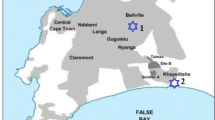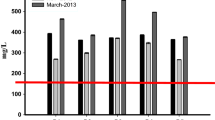Abstract
The qualities of the treated final effluents of a wastewater treatment plant located in a rural community of the Eastern Cape Province of South Africa were assessed over the duration of 12 months. Parameters measured include pH, temperature, electrical conductivity, salinity, turbidity, total dissolved solid, dissolved oxygen, chemical oxygen demand, nitrate, nitrite and orthophosphate levels and these were simultaneously monitored in the treated final effluents and the receiving watersheds using standard methods. Unacceptably, high levels of the assayed parameters were observed in many cases for chemical oxygen demand (7.5–248.5 mg/L), nitrate (1.82–13.14 mg/L), nitrite (0.09–1.3 mg/L), orthophosphate (0.07–4.81 mg/L), dissolved oxygen (4.15–11.22 mg/L) and turbidity (3.68–159.06 NTU) during the study period and are severally outside the compliance levels of the South African Guidelines and World Health Organization tolerance limits for effluents intended for discharge through public sewers into receiving watersheds. The study has revealed that there was an adverse impact on the physico-chemical characteristics of the receiving watershed as a result of the discharge of inadequately treated effluents from the wastewater treatment facility. This poses a health risk to several rural communities which rely on the receiving water bodies primarily as their sources of domestic water. There is need for the intervention of appropriate regulatory agencies to ensure production of high quality treated final effluents by wastewater treatment facilities in rural communities of South Africa.
Similar content being viewed by others
References
Aina, E. O. A.; Adedipe, N. O., (1996). Water quality monitoring and environmental status in Nigeria. FEPA Monograph 6, FEPA, Abuja, Nigeria, 239.
Calamari, D.; Naeve, H., (1994). Review of pollution in the African aquatic environment. Committee for Inland Fisheries of Africa (CIFA) Technical paper No. 25, FAO, Rome, 118.
Chapman, D., (1996). Water quality assessments: A guide to the use of biota, sediments and water in environmental monitoring 2nd. Ed. UNESCO, World Health Organization, United Nations Environment Programme, London.
Correll, D. L., (1998). The role of phosphorus and eutrophication of receiving waters. A review. J. Environ. Qual., 27, 261–266 (6 pages)
DEAT, (2000).White paper on integrated pollution and waste management for South Africa: A policy on pollution prevention, Waste minimization, impact management and remediation, Department of Environmental Affairs and Tourism, 80.
DFID, (1999). A Simple Methodology for Water Quality Monitoring. G. R. Pearce, M. R. Chaudhry and S. Ghulum (Eds.), Department for International Development Wallingford. 100.
DWAF; WRC, (1995). South African water quality management series. Procedures to Assess Effluent Discharge Impacts. WRC Report No. TT 64/94. Department of Water Affairs and Forestry and Water Research Commission, Pretoria.
DWAF, (1996a). South African Water Quality Guidelines. Domestic Uses. 2nd. Ed. Department of Water Affairs and Forestry, Pretoria, Vol. 1.
DWAF, (1996b). South African Water Quality Guidelines, (Volume 2), Recreational Water Use (2nd Ed.). Department of Water Affairs and Forestry, Pretoria.
DWAF, (1996c). South African Water Quality Guidelines, Aquatic ecosystems (1st. Ed.). Department of Water Affairs and Forestry, Pretoria, Vol. 7.
DWAF, (1996d). South African Water Quality Guidelines, Agricultural water use irrigation (2nd. Ed.). 4, Department of Water Affairs and ForestryPretoria. RSA.
DWAF, (1998). Quality of Domestic Water Supplies. Assessment Guide. 1 (2nd. Ed.) Department of Water Affairs and Forestry, Department of Health and Water Research Commission.
DWAF, (1999). Quality of domestic water supplies. Sampling Guide 2. Department of Water Affairs and Forestry, Department of Health and Water Research Commission.
Fatoki, S. O.; Muyima, N. Y. O.; Lujiza, N., (2001). Situation analysis of water quality in the Umtata River catchment. Water SA., 27(4), 467–474 (8 pages)
Fatoki, S. O.; Gogwana, P.; Ogunfowokan, A. O., (2003). Pollution assessment in the Keiskamma River and in the impoundment downstream. Water SA., 29(3), 183–187 (5 pages).
Government Gazette, (1984). Requirements for the purification of wastewater or effluent. Gazette No. 9225, Regulation, 991.
Holdsworth, R., (1991). New health consideration in water treatment. Avebury Technical Publications, Aldershot.
Jaji, M. O.; Bamgbose, O.; Odukoya, O. O.; Arowlo, T. A., (2007). Water quality assessment of Ogun River, south west Nigeria. Environ. Monit. Assess., 133(1–3), 447–482 (36 pages).
Lloyd, B.; Helmer, R., (1992). Surveillance of drinking water quality in rural area. Longman Scientific and Technical Publication. New York, Wiley. 34–56.
Mathuthu, A. S.; Zaranyika, F. M.; Jonnalagadda, S. B., (1993). Monitoring of water quality in Upper Mukuvisi River in Harare, Zimbabwe. Environ. Intern., 19(1), 51–61 (12 pages).
McCulloch, W. L.; Goodfellow, W. L. Jr.; Black, J. A., (1993). Characterization, identification and confirmation of total dissolved solids as effluent toxicants. Environ. Toxicol. Risk Assess., 2, 213–227 (14 pages).
Morokov, V. V., (1987). Assessment of river pollutant source. J. Water Res., 14, 1027–1041 (15 pages).
Morrison, G.; Fatoki, O. S.; Persson, L.; Ekberg, A., (2001). Assessment of the impact of point source pollution from the Keiskammahoek Sewage Treatment Plant on the Keiskamma River—pH, electrical conductivity, oxygen demanding substance (COD) and nutrients. Water SA., 27(4), 475–480 (6 pages).
Murray, K.; Du Preez, M.; Van Ginkel, C., (2000). National monitoring programme implementation manual draft. Water Research Commission, Pretoria.
Obire, O.; Tamuno, D. C.; Wemedo, S. A., (2003). Physico-chemical quality of Elechi Creek in Port Harcourt, Nigeria. J. App. Sci. Environ. Manag., 7(1), 43–49 (7 pages).
OECD, (1982). Eutrophication of waters: Monitoring, assessment and control. Organization for economic cooperation and development, technical report, Organization for Economic Cooperation and Development, Paris.
Ogunfowokan, A. O.; Okoh, E. K.; Adenuga, A. A.; Asubiojo, O. I., (2005). Assessment of the impact of point source pollution from a university sewage treatment oxidation pond on the receiving stream-a preliminary study. J. App. Sci., 6(1), 36–43 (7 pages).
Okoh, A. I.; Babalola, G. O.; Bakare, M. K., (1996). Microbial densities and physicochemical qualities of some crude oil flow stations saver pit effluents in the Niger Delta Area of Nigeria. Sci. Total Environ., 187(2), 73–78 (6 pages).
Okoh, A. I.; Barkare, M. K.; Okoh, O. O.; Odjadjare, E., (2005). The cultural microbial and chemical qualities of some waters used for drinking and domestic purpose in a typical rural setting of Southern Nigeria. J. Appl. Sci., 5(6), 1041–1048 (8 pages).
Okoh, A. I.; Odjadjare, E. E.; Igbinosa, E. O.; Osode, A.N., (2007). Wastewater treatment plants as a source of microbial pathogens in the receiving watershed. Afr. J. Biotech. 6(25), 2932–2944 (13 pages).
Olajire, A. A.; Imeokparia, F. E., (2001). Water quality assessment of Osun River: Studies on inorganic nutrients. Environ. Monitor. Assess., 69(1), 17–28 (11 pages).
Rao, P. V., (2005). Textbook of environmental engineering. Eastern Economy Ed., Prentice-Hall of India Private Limited, New Delhi, Chapter 3, 280.
Rapin, F.; Blanc, P.; Corvi, C., (1989). Eutrophication trends in the water quality of the Rhode River. J. Mar. Biol. Assoc., 54, 825–855 (31 pages).
Rast, W.; Thornton, J. A., (1996). Trends in eutrophication research and control. Hydrol. Proc., 10(2), 131–295 (165 pages).
SANCOR, (1984). Report of the ad hocworking committee. Lusher, J. A. (Ed.). Established by the Marine Pollution Committee of the South African National Committee for Oceanographic Research, South African Network for Coastal and Oceanic Research, 25.
UNEP, (1993). Environmental data report (93/94). United Nation Environment Programme, Blackwell, Oxford, UK, 63–105.
Whitfield, A.; Bate, G., (2007). A review of information on temporarily open/closed estuaries in the warm and cool temperate biogeographic regions of South Africa, with particular emphasis on the influence of river flow on These Systems. WRC Report No. 1581/1/07.
WHO, (1984). Guideline for Drinking Water Quality Recommendation. World Health Organization, Geneva, Vol.1, 130.
WHO, (1989). Health guidelines for use of wastewater in agriculture and aquaculture. World Health Organization. Technical Report Series 778. Geneva, Switzerland.
WHO, (2002). Water and health in Europe: A joint report from the European Environment Agency and the WHO Regional Office for Europe.World Health Organization, WHO Regional Publications, European Series No. 93.
WHO, (2004). Rolling revision of the WHO guidelines for drinking-water quality, Draft for review and comments. Nitrates and Nitrites in drinking-water, World Health Organization. (WHO/SDE/WSH/04.08/56).
WRC, (2000). National eutrophication monitoring programme. Water Research Commission. Implementation Manual. Draft Report, Water Research Commission, Pretoria.
Author information
Authors and Affiliations
Corresponding author
Rights and permissions
About this article
Cite this article
Igbinosa, E.O., Okoh, A.I. Impact of discharge wastewater effluents on the physico-chemical qualities of a receiving watershed in a typical rural community. Int. J. Environ. Sci. Technol. 6, 175–182 (2009). https://doi.org/10.1007/BF03327619
Received:
Revised:
Accepted:
Published:
Issue Date:
DOI: https://doi.org/10.1007/BF03327619




